Related Research Articles
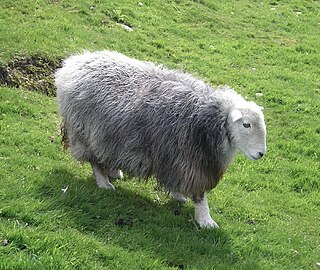
The Herdwick is a breed of domestic sheep native to the Lake District in North West England. The name "Herdwick" is derived from the Old Norse herdvyck, meaning sheep pasture. Though low in lambing capacity and perceived wool quality when compared to more common commercial breeds, Herdwicks are prized for their robust health, their ability to live solely on forage, and their tendency to be territorial and not to stray over the difficult upland terrain of the Lake District. It is considered that up to 99% of all Herdwick sheep are commercially farmed in the central and western Lake District.

The Manx Loaghtan is a rare breed of sheep native to the Isle of Man. It is sometimes spelled as Loaghtyn or Loghtan. The sheep have dark brown wool and usually four or occasionally six horns.

The Soay sheep is a breed of domestic sheep descended from a population of feral sheep on the 100-hectare (250-acre) island of Soay in the St Kilda Archipelago, about 65 kilometres (40 mi) from the Western Isles of Scotland. It is one of the Northern European short-tailed sheep breeds.

The Cotswold is a British breed of domestic sheep. It originates in, and is named for, the Cotswold hills of the southern midlands of England. It is a large long-woollen sheep, and is kept as a dual-purpose breed, providing both meat and wool.

The Lonk is a British breed of domestic sheep. It belongs to the group of black-faced hill breeds of northern England, and is found in the hills of the central and southern Pennines of Lancashire and Yorkshire. It is documented from the mid-eighteenth century; a flock book was started in 1905.

The Oxford Down is a British breed of domestic sheep. It was developed in the 1830s by cross-breeding of Hampshire Down and Southdown ewes with Cotswold rams. It is reared primarily for meat.

The Balwen Welsh Mountain sheep is one of a number of varieties of Welsh Mountain sheep, bred for sheep farming in Wales. It has a distinctive colour pattern of a black body with white extremities. It originates in the Tywi valley in Wales. This breed is raised primarily for meat.
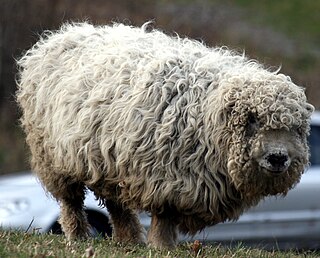
The Greyface Dartmoor is a rare breed of domestic sheep originating around Dartmoor in south west England. Also known as the "Improved Dartmoor", this is a large and long-woolled breed, known for its distinctive facial markings. Its fleece can weigh 7 to 9 kg, and today the breed is primarily raised for meat.

The Norfolk Horn is one of the British black-faced sheep breeds. It differs from other black-faced breeds, which are mainly found in high-rainfall, upland areas, and from most other modern, lowland British sheep breeds in being lightly built and very hardy. This breed is raised primarily for meat.

The Portland is a sheep breed that takes its name from the Isle of Portland in Dorset, England. This breed is raised primarily for meat.

The Clun Forest is a breed of domestic sheep originating from the area surrounding the Clun Forest in Shropshire, England. Similar to many of the British breeds of upland sheep, Clun Forest are hardy, adaptable, good foragers, and are long–lived. With sleek heads and wide pelvic structures, Clun Forest ewes lamb easily. The breed has a short to medium–length wool and dark brown faces. They are a multi–purpose animal, kept for meat, wool, and milk. Like other dark faced sheep, Clun produce quality lamb and mutton. However, in contrast to more common meat breeds such as Suffolks, their wool is free of undesirable black fibres and kemp, and is suitable for handspinning. The breed's alert and stylish appearance, together with its reputation for hardiness and fecundity have made it popular with hobby farmers and large commercial flock owners alike. The Official Clun Sheep Breeders Society Show & Sale for males and females is held annually in early September at Ludlow livestock market by McCartneys.

The Castlemilk Moorit is a rare breed of domestic sheep originating in Dumfriesshire in Scotland.
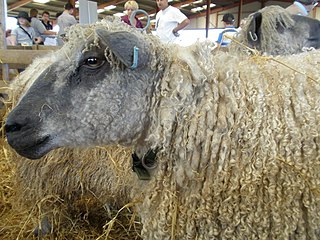
The Wensleydale is a British breed of domestic sheep. It is named for the Wensleydale region of North Yorkshire, in the north of England, where it was bred in the early nineteenth century by cross-breeding a Dishley Leicester ram with local long-woolled sheep of a breed that is now extinct. It has a blue-grey face and long purled wool, and is among the heaviest of British sheep breeds. It is an endangered breed, and is categorised as "at risk" by the Rare Breeds Survival Trust. It is often used as a ram breed to cross with other breeds to obtain market lambs, and for its high-quality wool.
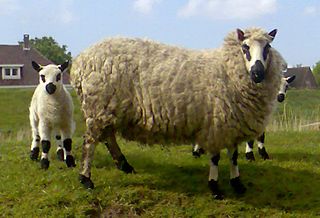
The Kerry Hill is a breed of domestic sheep originating in the county of Powys in Wales. It derives its name from the village of Kerry (Ceri), near Newtown. Kerry Hill sheep have a distinctive and unique coloration, with a white face bearing black markings around the mouth, ears, and eyes. Both rams and ewes are polled. Their wool is white, and their legs are white with black markings. First mentions of the breed date back to the early 19th century, and today it is distributed throughout the United Kingdom, Ireland, the Netherlands, Germany and Denmark. Though still not very numerous, the breed was removed from the records of the Rare Breeds Survival Trust watchlist in 2006. This breed is primarily raised for meat.
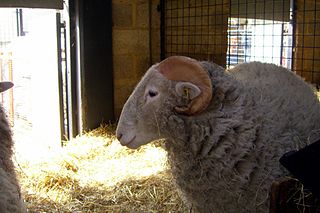
Whitefaced Woodland sheep originated on the Pennine hills around the Woodland Valley, which links Derwent and Ladybower to the Snake Pass and Glossop. It is a combination of two breeds, the Woodland and the Penistone sheep after the Yorkshire town where sheep sales have been held since 1699. It is thought to be closely related to the Swaledale and the Lonk. Substantial commercial flocks of the Whitefaced Woodland are kept in its region of origin, but it is listed as a priority breed by the Rare Breeds Survival Trust

The Teeswater is a breed of sheep from Teesdale, England. It is a longwool breed that produces a generally large-diameter fibre. However, the animals are raised primarily for meat.

The Boreray, also known as the Boreray Blackface or Hebridean Blackface, is a breed of sheep originating on the St Kilda archipelago off the west coast of Scotland and surviving as a feral animal on one of the islands, Boreray. The breed was once reared for meat and wool, but is now used mainly for conservation grazing. The Boreray is one of the Northern European short-tailed sheep group of breeds.

The Llanwenog is a breed of domestic sheep originating in Wales. It was developed in the 19th century from the Llanllwni, the Shropshire, Welsh Mountain, and Clun Forest breeds. The Llanwenog's native locale is the Teifi Valley, in western Wales, but it has since spread into other areas. The breed association was formed in 1957. Llanwenogs have black faces and medium-length wool. They have a docile temperament and are known for their profligacy in lambing. The breed has a very placid temperament, is easily handled, easily contained and is well suited to stress free inwintering if necessary. This has important consequences for the health of both the animal and its keeper. This breed is raised primarily for meat.
The Hill Radnor is a breed of domestic sheep originating in the United Kingdom. Classified as one of the mountain breeds, it is most common from Powys down to southwest Herefordshire and Monmouthshire. The Hill Radnor has a dense white fleece, with a light brown face and legs. Ewes are polled and rams are horned. It is hardy and forages well, like many hill breeds. Hill Radnor ewes have good maternal instincts, and are sometimes crossed with lowland rams to yield market lambs or mules. Lambing percentages vary under different conditions but the breed can easily average around 155%. The breed is listed as "vulnerable" by the Rare Breeds Survival Trust of the U.K.
The Devon Closewool is a British breed of domestic sheep. It is distributed almost exclusively on Exmoor in North Devon, in south-west England. It is raised primarily for meat.
References
- 1 2 "Whiteface Dartmoor". Sheep Breeds V-Z. Sheep101.info. Retrieved 2009-05-07.
- 1 2 "White Face Dartmoor". Watchlist. Rare Breeds Survival Trust. Archived from the original on 27 December 2016. Retrieved 2009-05-07.
- ↑ "Whiteface Dartmoor/United Kingdom". Breed Data Sheet. Domestic Animal Diversity Information System. Retrieved 2009-09-09.